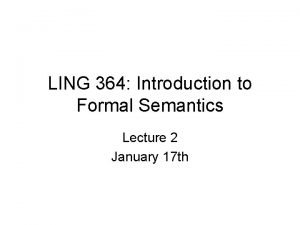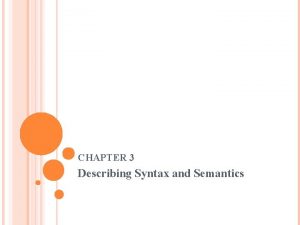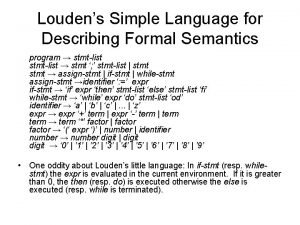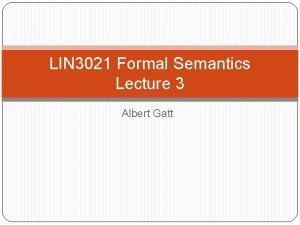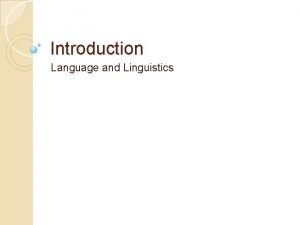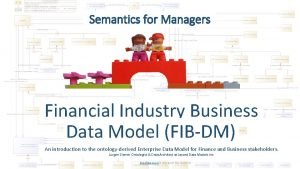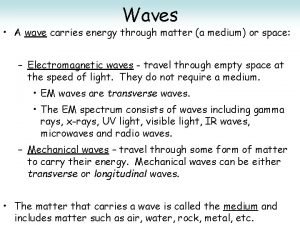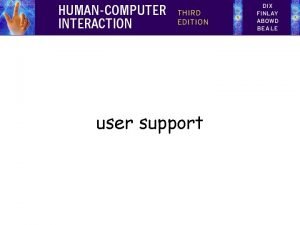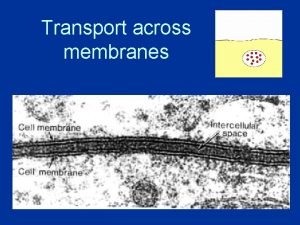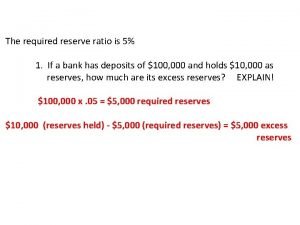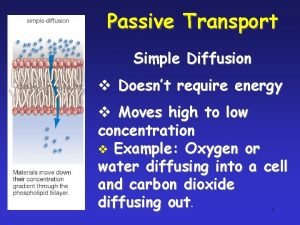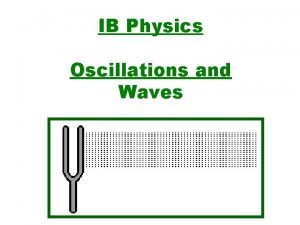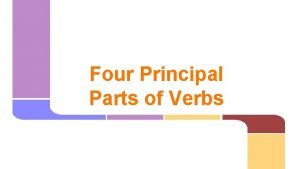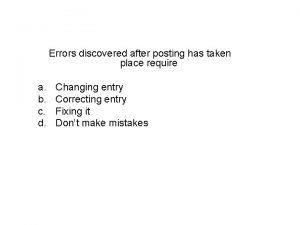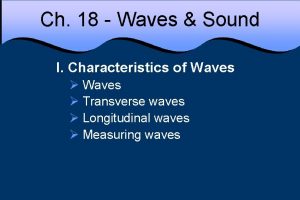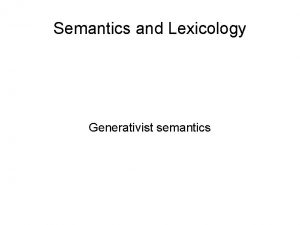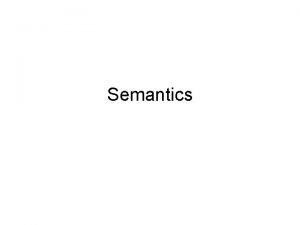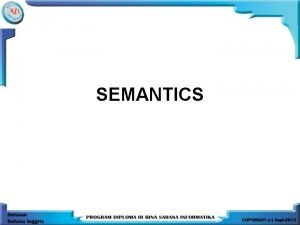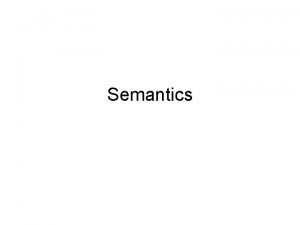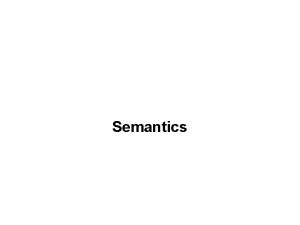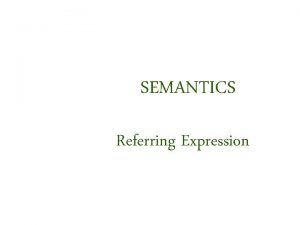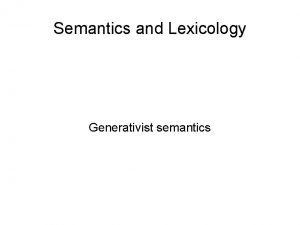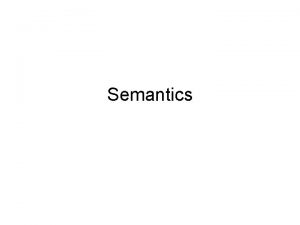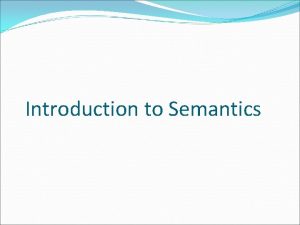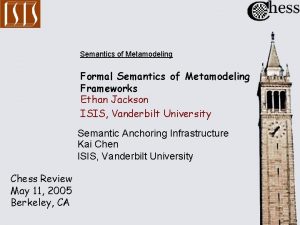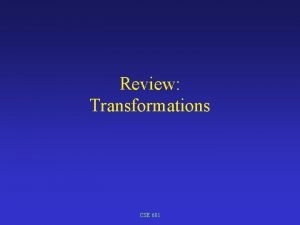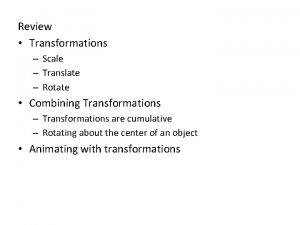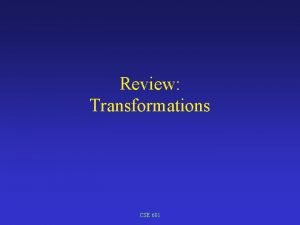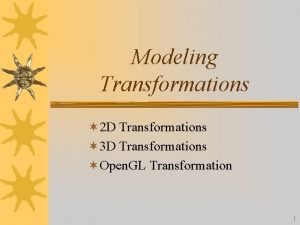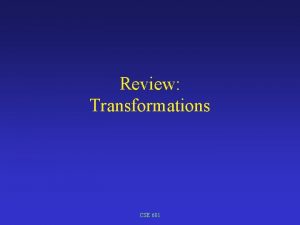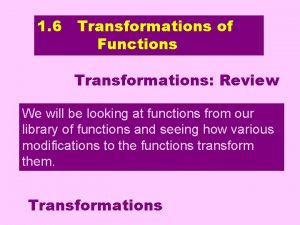Model Transformations Require Formal Semantics Yu Sun 1

![Overview Metamodeling Environments Motivation Methods for Representing Semantics in Grammarware C [[ left ]] Overview Metamodeling Environments Motivation Methods for Representing Semantics in Grammarware C [[ left ]]](https://slidetodoc.com/presentation_image/d8005a9fe7a803a77f63f3b98cff013a/image-2.jpg)
















- Slides: 18

Model Transformations Require Formal Semantics Yu Sun 1, Zekai Demirezen 1, Tomaz Lukman 2, Marjan Mernik 3, Jeff Gray 1 1 Department of Computer and Information Sciences, University of Alabama at Birmingham {yusun, zekzek, gray}@cis. uab. edu 2 Jožef Stefan Institute Dept. of Systems and Control tomaz. lukman@ijs. si 3 University of Maribor, Slovenia marjan. mernik@uni-mb. si This work funded in part by NSF CAREER award CCF-0643725.
![Overview Metamodeling Environments Motivation Methods for Representing Semantics in Grammarware C left Overview Metamodeling Environments Motivation Methods for Representing Semantics in Grammarware C [[ left ]]](https://slidetodoc.com/presentation_image/d8005a9fe7a803a77f63f3b98cff013a/image-2.jpg)
Overview Metamodeling Environments Motivation Methods for Representing Semantics in Grammarware C [[ left ]] (x, y) = (x+Δx, y+Δy) where Δx=-1 and Δy=0 C [[ right ]] (x, y) = (x+Δx, y+Δy) where Δx=+1 and Δy=0 C [[ down ]] (x, y) = (x+Δx, y+Δy) where Δx=0 and Δy= -1 C [[ up ]] (x, y) = (x+Δx, y+Δy) where Δx=0 and Δy=+1 C [[ C 1 C 2 ]] (x, y) = let (x+Δx 1, y+Δy 1) = C [[ C 1]] (x, y) in let (x+Δx 1+Δx 2, y+Δy 1+Δy 2) = C [[ C 2]] (x+Δx 1, y+Δy 1) in (x+Δx 1+Δx 2, y+Δy 1+Δy 2) Define a Semantics for the DSML Robot DSL/DSML Model Transformation has to preserve behavior Define Optimization for the DSML Background Goals Case Study Prove the Optimization Correctness

Motivation A primary shortcoming that can be found in many model transformation approaches and tools is the lack of formal semantics to define the meaning of a modeling abstraction An example of transformation is the modification of a particular source code (or model) to support some desired optimization One essential requirement of optimization is to ensure that the semantics of the program (or model) is preserved in the whole process of optimization The more mature foundation of programming language theory could be used to define the semantics of a DSL such that a formal optimization proof is realizable

Approaches to Define Language Semantics Attribute grammar is a context-free grammar augmented with attributes and semantic rules. Denotational semantics formalizes the meanings of a programming language by constructing mathematical objects. Operational semantics specifies a programming language in terms of program execution on abstract machines.

Robot DSL PROGRAMMAR P Program C Command P : : = begin C end C : : = left | right | up | down | C 1 C 2 begin left up down up end DENOTATIONAL SEMANTICS P : Program → Int*Int P [[ begin C end ]] = C [[ C ]] (0, 0) C : : Command → Int*Int C [[ left ]] (x, y) = (x+Δx, y+Δy) where Δx=-1 and Δy=0 C [[ right ]] (x, y) = (x+Δx, y+Δy) where Δx=+1 and Δy=0 C [[ down ]] (x, y) = (x+Δx, y+Δy) where Δx=0 and Δy=-1 C [[ up ]] (x, y) = (x+Δx, y+Δy) where Δx=0 and Δy=+1 C [[ C 1 C 2 ]] (x, y) = let (x+Δx 1, y+Δy 1) = C [[ C 1]] (x, y) in let (x+Δx 1+Δx 2, y+Δy 1+Δy 2) = C [[ C 2]] (x+Δx 1, y+Δy 1) in (x+Δx 1+Δx 2, y+Δy 1+Δy 2)

Program Optimization in DSL In Optimization 1, the sequence of moves can be rearranged so that the same type of moves are adjacent The rationale behind Optimization 1 is that the robot can move faster if there is no need to change the direction In Optimization 2, some combinations of moves have no effect and can be eliminated

Optimization Correctness in DSL To prove "begin C 1 C 2 end" = "begin C 2 C 1 end" We have to show that: P [[ begin C 1 C 2 end ]] = P [[ begin C 2 C 1 end ]] In other words, we have to prove: C [[ C 1 C 2 ]] (0, 0) = C [[ C 2 C 1 ]] (0, 0) Since: C [[ C 1 C 2 ]] (0, 0) = let (Δx 1, Δy 1) = C [[ C 1]] (0, 0) in let (Δx 1+Δx 2, Δy 1+Δy 2) = C [[ C 2]] (Δx 1, Δy 1) in (Δx 1+Δx 2, Δy 1+Δy 2) C [[ C 2 C 1 ]] (0, 0) = let (Δx 2, Δy 2) = C [[ C 2]] (0, 0) in let (Δx 2+Δx 1, Δy 2+Δy 1) = C [[ C 1]] (Δx 2, Δy 2) in (Δx 2+Δx 1, Δy 2+Δy 1) Also: (Δx 1+Δx 2, Δy 1+Δy 2) = (Δx 2+Δx 1, Δy 2+Δy 1) (due to associativity of +) We can get: C [[ C 1 C 2 ]] (0, 0) = C [[ C 2 C 1 ]] (0, 0) Therefore: P [[ begin C 1 C 2 end ]] = P [[ begin C 2 C 1 end ]]

DSML Semantics Can we utilize a DSL semantics formalism to define optimizations in DSML? Current state of the art tools GME Atom 3 GEMS Kermeta

M e t a m o d e l DSML Platforms and Semantics GME Metamodeling Interface Application Domain Application Evolution App 1 Metamodel Definition DEFINE App 2 Model Builder Meta-Level Translation INTERPRET void CComponent: : Invoke. Ex(CBuilder &buil der, CBuilder. Object *focus, CBui lder. Object. List &selected, long param) { CString DMSRoot = ""; DMSRoot = Select. Folder("Please Select DMS Root Folder: "); if (DMSRoot != "") { DMSRule. Path = DMSRoot + RULESPATH + "Rules\"; MSRule. Applier. Path = DMSRoot + RULESPATH + "Rule. Applier\"; Afx. Message. Box("DMSRule. Path = " + DMSRule. Path , MB_OK); CString OEPRoot = ""; OEPRoot = Select. Folder("Please Selec App 3 The semantics of the a DSML is hard-coded into the model interpreter Modeling Environment M o d e l I n t e r p r e t e r Environment Evolution Model Interpretation Models Model Interpreters

DSML Platforms and Semantics Atom 3 Graph Rewriting Robot Metamodel Left Action Semantics LHS RHS = Pos_x Pos_y Pos_x-Pos_y

DSML Platforms and Semantics GEMS Interpreter Robot Metamodel Robot Semantics int public class Robot. Interpreter extends Abstract. Interpreter{ temp_x=Integer. parse. Int((String)(tovisit. get. Parent(). get. Attribute("Pos_x"))); public void visit. Left(Left tovisit) { int temp_x = Integer. parse. Int((String)(tovisit. get. Parent(). get. Attribute("Pos_x"))); int temp_y = Integer. parse. Int((String)(tovisit. temp_y=Integer. parse. Int((String)(tovisit. get. Parent(). get. Attribute("Pos_y"))); Make. Action((Robot)(tovisit. get. Parent()), tovisit, temp_x, temp_y); Make. Action((Robot)(tovisit. get. Parent()), display. Robot. Position(tovisit); visit. Container(tovisit); tovisit, temp_x, temp_y); } public void visit. Right(Right tovisit) { … } public void visit. Up(Up tovisit) { … } public void visit. Down(Down tovisit) { … display. Robot. Position(tovisit); visit. Container(tovisit);

DSML Platforms and Semantics Kermeta Robot Metamodel Robot Semantics Run() Move(Robot r) class Robot attribute reference { pos_x: int; pos_y: int; action. List: Action[0. . 1]; operation run(): int is do action. List. move(this); end } class Action{ operation move(r: Robot ): int is do end } class Left{ operation move(r: Robot): int{ r. pos_x: =r. pos_x-1; } }

Problems Related with DSML Semantics Lack of semantic reasoning, which is needed for proofs Lack of formal proof of the optimization Hard to comprehend semantics Hard to generate model interpreters automatically Difficulties in compiler verification Limitations in proving properties of domain concepts Lack of connection between Transformation and Semantic Layers

Defining DSML Optimization #2 Optimization #1 Model Transformation by Example

Model Optimization in DSML Optimization #1 Optimization #2

Conclusion Due to the lack of formal semantics for DSMLs, the real meaning of a modeling language is available only in associated model interpreters As a consequence, model transformations cannot be verified for preserving the semantics Traditional programming language theory could be used to define the semantics of a DSML such that a formal optimization proof is realizable Future Work: Proof for DSML optimization

Question? Comments? zekzek@uab. edu www. cis. uab. edu/zekzek This work funded in part by NSF CAREER award CCF-0643725.

Robot DSML Syntax Metamodel Semantics Metamodel
 Compare procedural semantics and declarative semantics.
Compare procedural semantics and declarative semantics. What is formal semantics
What is formal semantics General problem of describing syntax and semantics in ppl
General problem of describing syntax and semantics in ppl Formal semantics
Formal semantics Formal semantics
Formal semantics What is formal semantics
What is formal semantics Financial industry business data model
Financial industry business data model Parts of a longitudinal wave
Parts of a longitudinal wave Mechanical wave energy
Mechanical wave energy What are the 4 main types of assistance that users require?
What are the 4 main types of assistance that users require? Does exocytosis require energy
Does exocytosis require energy Cash reserve ratio
Cash reserve ratio Apa title page format
Apa title page format Does simple diffusion require energy
Does simple diffusion require energy Toh
Toh Principal verbs
Principal verbs Errors discovered after an entry is posted
Errors discovered after an entry is posted What waves don't require a medium
What waves don't require a medium What waves don't require a medium
What waves don't require a medium

